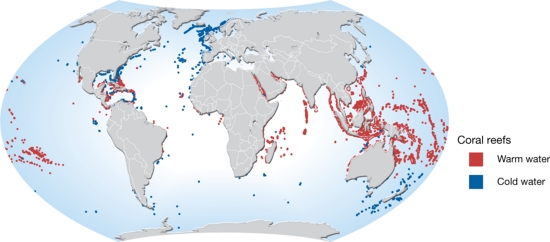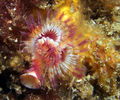Coral reefs
This article describes the habitat of the coral reefs. It is one of the sub-categories within the section dealing with biodiversity of marine habitats and ecosystems. It gives an overview of the formation, distribution, biology, zonation, requirements for development, biota and threats.
Contents
Introduction
Coral reefs are one of the most diverse ecosystems in the world. The organisms belong to the Phylum Cnidaria. The best known type of corals is the one living in clear, warm tropical waters with plenty of colourful fishes. This is a rocky, shallow water type. The water is clear because of the low concentrations of nutrients. But there are also deep water corals that live in dark cold waters and soft corals that live in shallow, cold waters. They are wave resistant rock structures, created by calcium carbonate -secreting animals and plants.

Formation
The formation of corals begins when free-swimming coral larvae attach to submerged rocks or other hard substrate along the edges of islands or continents. The reef expands and will form an atoll, barrier or fringing reef. These 3 are the main reef types. Atolls are circular or oval coral reefs that partially or completely encircle a lagoon. A barrier reef is a reef that borders the shoreline over a long distance. They are separated from the adjacent land mass by a lagoon. A fringing reef forms borders along the shoreline and the surrounding islands, but at shorter distance than barrier reefs. It is directly attached to the land. This is the most common type of coral reefs [2]. Other special reef arrangements are apron, patch, ribbon, table and bank reefs. Apron reefs are very similar to fringing reefs. Both are extending downward from the land margin, the former more gently sloping than the latter. Patch reefs are small, isolated outcrops of coral surrounded by sand and/or seagrass, and may form part of a fringing reef system. Ribbon reefs are the small and long components of a barrier or are connected to an atoll lagoon. Table reefs are future atolls, but are not yet connected to a lagoon. At last, bank reefs are similar to the patch reefs, but are larger and often hemispherical.
Coral reefs are also among the oldest habitats in the ocean. They have slow growth rates and it may take up to 10,000 years for a coral reef to fully develop from the first colonising larvae [3]. The different types all share similarities in their biogeographic profiles. Horizontal and vertical zonation depends on bottom topography, depth, wave and current strength, light, temperature and suspended sediments.
Distribution
The warm water corals are found in the tropics (between 30°N and 30°S) in areas where the water is clear and over 18°C. The maximum depth for warm water corals is generally around 60 meters.
Some species of coral are found in all oceans of the world. Cold water corals have been found in places as Antarctica, Australia, Canada, Ecuador, Japan, New Zealand, Europe and the United States.

Biology
The principal reef-building organisms are hard coral (scleractinian corals). The formation starts with a larva known as planula that settles down and attaches itself to a hard substrate. Then the larva develops into a coral polyp and secretes calcium carbonate around its body. The reproduction is by budding, an asexual process. As the asexual reproduction continues, the colony grows. Some polyps in the colony develop gonads and are able to reproduce sexually. These polyps release sperm and eggs in the surrounding water. To help with fertilization, both eggs and sperm cells have protein molecules on their surfaces to identify other cells of the same species. [5]
The coral polyp has a sac-like structure that is protected by a rigid calcium-carbonate exoskeleton. This is called a corallite. The bottom of the corallite is divided into vertical segments or septa. At the top, the polyp has an opening that is a combined mouth and anus. This leads to the gut. The opening is surrounded by tentacles with mucus secreting cells for catching prey. Zooxanthellae (Dinoflagellates) are embedded in the outer layer of the coral’s flesh (epidermis), giving the coral it's color. This causes a stable environment for them. The cells are abundant and can represent up to 75% of the tissue weight. The zooxanthellae require sunlight for photosynthesis. They provide nutrients to the polyps and reduce the level of carbon dioxide. This makes the conditions for the formation of skeletons more suitable. In turn, the zooxanthellae get a suitable habitat. The coral species which harbour the zooxanthellae are called hermatypic.
Not all corals are reef building species. There are also hard corals existing as single, solitary polyps. Some temperate species form small colonies only. Corals that lack the hard outer coverings of calcium carbonate are soft corals. Cold water corals lack the symbiontic Dinoflagellates. The species without zoooxanthellae is called ahermatypic.
Zonation
On the seaward side, the reef rises from the lower depths of the ocean to a level just at or just below the surface of the water. This is called the reef front or fore-reef. The slope of this area varies from gentle to steep. It sometimes forms a vertical wall known as a drop-off. But generally, the reef front forms finger-like arrangements called spur and groove formations. It breaks the wave energy and prevents damage to the reef. The grooves are sand-filled pockets, which allow sediment to be channelled down and away from the coral surface and provide a habitat for many species of burrowing organisms. The reef crest is the highest point of the reef. More land inward, the reef flat or back reef is formed. This area has a high variability. The bottom of the reef flat consists of rock, sand, coral cobble or a combination of these. Seagrasses are commonly found in this area. The reef ends at the shoreline or descends into the lagoon.
The different levels in the zonation support different species. On the on the intermediate slopes of the reef front, dome-shaped, massive brain corals (Diploria) and columnar pillar corals (Dendrogyra) are found. Below this region, plate corals such as Pectinia, Pavona and Agaricia are found. Higher upon the reef, where wave stress is greatest, there are branched species of coral. A coral that occurs in the region is elkhorn coral (Acropora palmata). Behind the reef front, more protected areas are occupied with more delicate species such as staghorn coral (Acropora cervicornis), finger (Stylophora), cluster (Pocillopora) and lace corals (Pocillopora damicornis). In shallow, calmer waters away from the reef front, small species such as rose (Meandrina, Manicina), flower (Mussa, Eusmilia) and star (Montastraea) corals are found. [6]
Elkhorn coral (Acropora palmata)
Staghorn coral (Acropora cervicornis) Photo credit W. Jaap
Brain coral (Diploria strigosa) [7]
Pillar coral (Dendrogyra cylindrus) [8]
Conditions for growth
Reef-building, warm water corals need the following environmental conditions to grow:
- Clear water : this allows light to reach the photosynthetic zooxanthellae
- Light-absorbing adaptations enable some species to live in dim blue light
- Ocean temperatures of more than 18°C
- Strong wave action which ensures: supply of food and oxygen, the distribution of larvae and prevents sediment to settle on the reefs
- Precipitation of calcium necessary for the formation of skeletons. Water temperatures and salinity have to be high and carbon dioxide concentrations have to be low.
- hard substrate
Cold water corals do not need light to function. They obtain their nutrients and energy completely from trapping plankton and organic particles in passing currents. They include stone corals, true soft corals, black corals and lace corals. Most of them do not build reefs, but grow in thick colonies. All cold water corals are extremely fragile and vulnerable to physical disturbance. The polyps cannot escape disturbances and their structures are extremely brittle. They also grow extremely slow, so it takes a long time to rebuild the reef when it is damaged. An additional disadvantage is that can't respond to fast-occurring changes in their environment, because have adapted to stable conditions. [9]
Cold water corals such as Lophelia are true hard corals. They also produce calcium carbonate skeletons. They are mainly found at depths between 200 and 1,000 meters along continental shelves, in fjords and around offshore submarine banks, vents and seamounts. The suitable temperature ranges from 4°C to 13°C. Lophelia is not found in the polar regions. Madrepora oculata is another cold water coral species. The species is found in the north-east and western Atlantic and the Mediterranean Sea.
Biota
Coral reefs provide a structured habitat with a lot of niches for many species. They can play a role as shelter and nursery ground. Many reef animals are sessile or move very slowly. Sponges are found at deeper parts of the reef front. Smaller animals are found in the waters behind the reef. Anemones remain fixed in one place by a muscular, mucus-secreting basal disk. If the conditions become unfavourable, some sessile species can release themselves and crawl over the bottom, searching for a more suitable area. Fanworms or featherduster worms are represented by two families: the serpulid worms, which produce tubes of calcium carbonate, and sabellid worms, which form tubes of sand and small particles pasted together by mucus. Organisms that can be found on the branches of the coral reefs are: fish, crustaceans, starfish, molluscs, brittle stars, sea pens, sea urchins and squids. Sponges, bryozoans, hydroids, and some other coral species are found on the coral itself. The octopus is one of the most formidable predators. It can rapidly change its colour in response to its background (camouflage) and has very sharp eyesight. They have the ability to squeeze through small spaces where potential predators cannot gain access. Although the octopus is very well adapted to the environment, the moray eel is the dominant nocturnal predator. They live in cracks, crevices and holes. At night, they come out to feed on shrimps, crabs, octopuses and other fish. During the day, the barracuda takes it place as the dominant predator. [10]
Moray eel [11]
Common octopus (Octopus vulgaris) [12]
Barracuda (Sphyraena barracuda) Photo credit NOAA
Brittle star [13]
Serpulid worm (Serpula columbiana)
Threats
Natural causes are:
- Storms and tidal emersions
- El Niño: increased sea surface temperatures, decreased sea level and increased salinity from altered rainfall
- Predation by fishes, marine worms, barnacles, crabs, snails and sea stars
- Dust outbreaks
Human induced causes are:
- Chemical pollution
- Ocean acidification
- Fishery
- Land development
- Dredging and dumping
- Global warming
Related articles
References
- ↑ http://en.wikipedia.org/wiki/Coral_reef
- ↑ NOAA National Ocean Service Education: Corals
- ↑ Barnes R.D. 1987. Invertebrate Zoology. Fifth edition. Fort Worth, TX. Harcourt Brace Jovanovich College Publishers. 92-96, 127-134, 149-162.
- ↑ UNEP/GRID-Arendal - Hugo Ahlenius
- ↑ Karleskint G. 1998. Introduction to marine biology. Harcourt Brace College Publishers. p.378
- ↑ Karleskint G. 1998. Introduction to marine biology. Harcourt Brace College Publishers. p.378
- ↑ http://nl.wikipedia.org/wiki/Hersenkoraal - Photo credit Albert Kok
- ↑ http://en.wikipedia.org/wiki/Dendrogyra - Photo credit NOAA
- ↑ WWF. 2001. Cold water corals: fragile havens in the deep. p. 12
- ↑ Karleskint G. 1998. Introduction to marine biology. Harcourt Brace College Publishers. p.378
- ↑ http://en.wikipedia.org/wiki/Moray_eel
- ↑ http://en.wikipedia.org/wiki/Octopus - Photo credit Albert Kok
- ↑ http://en.wikipedia.org/wiki/Brittle_star
Please note that others may also have edited the contents of this article.
|

















